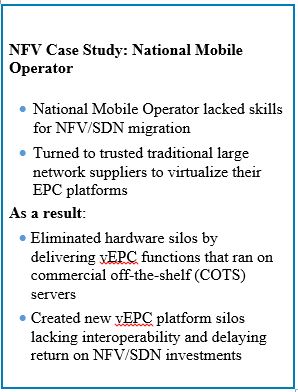As discussed in Failure to Migrate: A Case Study in NFV Deployment, despite considerable investment, Communications Service Providers (CSPs) have been slow to realize the advantages of Network Functions Virtualization (NFV) and Software Defined Networking (SDN) are critical to remaining competitive—especially with new over-the-top (OTT) players entering the market.
A recently published white paper, Bridging the IT/Network Operations Gap to Accelerate NFV Deployment and Achieve Operational Excellence, identifies cultural and practical differences between IT and network operations as a major stumbling block keeping operators from fully leveraging the agility, dynamic scaling, and efficiency advantages of network virtualization.
In this, the second in a series of CSP case studies, we look at yet another operator’s experience with NFV deployment and how an architectural approach integrating IT virtualization from the start could have accelerated return investment while keeping future options open.
Case Study #2: From Old Silos to New Silos
This national mobile operator, determined to move forward with NFV, had strong internal core network competencies, but lacked virtualization expertise and experience.
While staff were adept at meeting network service level agreements (SLAs), maintaining network facilities and managing network traffic, they were unfamiliar with:
– Technologies in the virtualization stack
– Designing flow architecture for software-defined networks
– Managing software-defined networks
– Orchestrating workloads across network domains
– DevOps service delivery models
Limited Choice: Niche or Proprietary?
To supplement its in-house expertise, the CSP planned to leverage services and solutions in the “ecosystem” of software-defined network solution and service vendors touted in NFV lab trials, by ETSI, and others.
In practice, however, it discovered its choice of partners was starkly limited to:
- New suppliers that had delivered innovative technical solutions in the lab or in small scale node-based deployments, but had yet to been proven in large-scale production networks.
- Traditional network suppliers with the proven capability to deliver production-reliability at scale, but with solutions designed largely around their own products.
Fear of the Unknown
Given network operations reservations about the reliability of software-defined networks, the CSP decided against working with untested smaller companies and opted to partner instead with its existing large network suppliers.
To avoid vendor lock-in, it asked both of its radio access network (RAN) suppliers to virtualize their Evolved Packet Core (vEPC) platform using NFV/SDN. It also directed them to incorporate open system technology into their vEPC solutions to optimize interoperability.
Battle of the New Silos
Unfortunately, what ensued was a battle between vendors and two new silos.
While both suppliers succeeded in delivering vEPC functions that ran on commercial off-the-shelf (COTS) servers, each had virtualized EPC and related applications in a unique way. As a result, each required their own unique orchestrator to manage the virtual network.
Neither vendor could develop an orchestration solution for both platforms.
Recognizing that multiple orchestrators would negate many of the agility and efficiency advantages of NFV, the CSP eventually turned to a third-party provider of a multivendor orchestrator built on open source technology. The CSP also hired and invested in training in its staff to be able to implement and manage the open source virtualization stack.
Bottom line, the CSP is now working to consolidate its vEPC silos into a single platform. The cost savings and automated agility it had expected to gain from its investment in NFV/SDN has not been realized and critical 5G and IoT initiatives have been delayed.
New Ways of Thinking

How might this mobile operator have avoided the complicated and interim step of replacing old hardware platform silos with new virtual platform silos?
The CSP’s initial strategy—to leverage outside expertise to kick start its NFV initiative—was sound, as was its commitment to open source technologies to optimize interoperability.
Their mistake?
To turn to two different traditional network partners who were unable or unwilling to provide vendor independent network choices.
Traditional network vendors will naturally want to deploy virtualized applications and infrastructure based on their own products, but if asked by the customer to provide vendor independent aspects to the implementation, many could accommodate this request. CSPs now have the option to pair their traditional network vendors with open, non-proprietary infrastructure. By doing so, they can now take advantage of a virtual infrastructure that will dynamically and automatically adapt to changing workload demands and unpredictable and varying traffic patterns.
In short, by building upon proven and open infrastructure solutions, they can take a holistic view and architectural approach across physical, virtual and application layers.
Based on our experience working with CSPs on some of the largest NFV deployments in the world, including the largest OpenStack Infrastructure as a Service (IaaS) deployment, we recommend an application-driven strategy. Applications, not infrastructure, drive revenue. However, choosing the wrong infrastructure can hamper revenue and increase OpEx.
Therefore, the virtualized network function (VNF) application requirements should drive the definition of a common architecture, infrastructure, and set of tools across both IT and Network Operations.
A composable architecture, with Management and Orchestration layers that mediate between different application requirements, for example, should guide the selection of the right partners to help onboard required VNFs, test and certify the underlying infrastructure, integrate VNFs into OSS/BSS functions, and deploy proof of concept.
By stepping back from the traditional closed and proprietary network viewpoint and implementation to leverage consultative and architectural expertise integrating both legacy network and IT virtualization from the start, this operator could have avoided replacing old silos with new silos—and considerable time and cost delays.
Summary
As CSPs work toward envisioning and executing NFV-based capabilities in their networks to help them conduct business in smarter and more agile ways, look for solutions that bring:
- Open architecture – offering maximum choice, flexibility and investment protection, without forklift upgrades.
- Modular systems – with open building blocks enabling mix and match interoperability, up and down the stack.
- Modern, cloud-centric portfolio – comprising of modern systems and technologies, and supporting the leading Linux and OpenStack distributions plus software options for data plane acceleration and service chaining.
- Scalable solutions – including systems tailored to your multitude of workloads and designed to grow with your business.
Next time: Skepticism at the Top: A Case Study in NFV Deployment


